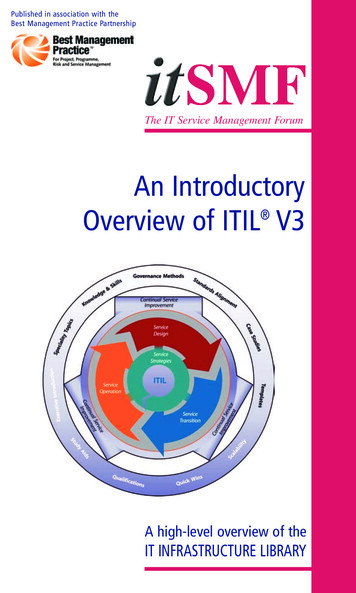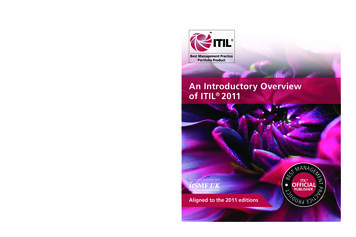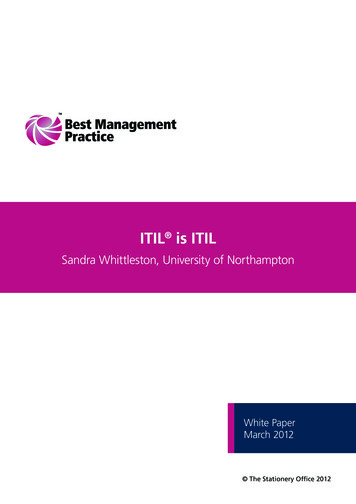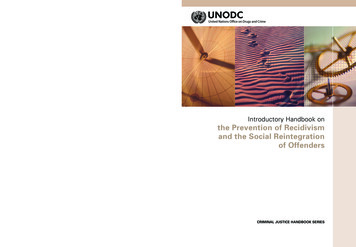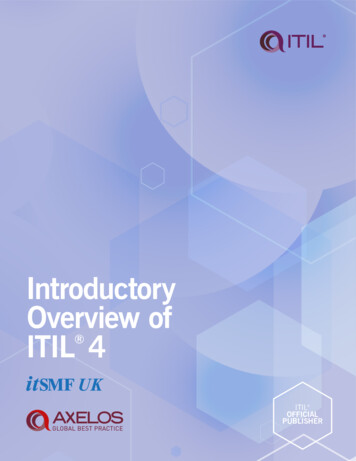
Transcription
Introductory Overview of ITIL 4IntroductoryOverviewof ITIL 4ITIL OFFICIALPUBLISHERi
Published by TSO (The Stationery Office), part of Williams Lea,and available from:Onlinewww.tsoshop.co.ukMail, Telephone, Fax & E-mailTSOPO Box 29, Norwich, NR3 1GNTelephone orders/General enquiries: 0333 202 5070Fax orders: 0333 202 5080E-mail: customer.services@tso.co.ukTextphone 0333 202 5077TSO@Blackwell and other Accredited AgentsCopyright AXELOS Limited 2020All rights reserved. No part of this publication may be reproduced in any form or by any meanswithout permission in writing from AXELOS Limited.Applications to reuse, reproduce or republish material in this publication should be sent to thelicensing team at: licensing@AXELOS.comRegistered office address: 30 Berners Street, London, England, W1T 3LRAXELOS, the AXELOS logo, the AXELOS swirl logo, AgileSHIFT , ITIL , MoP , M o R , MoV ,MSP , P3M3 , P3O , PRINCE2 , PRINCE2 Agile , and RESILIA are registered trade marks ofAXELOS Limited.10/20
ContentsAcknowledgementsviAbout this guidevii1Introduction12What is service management?43What is ITIL?64Key concepts of ITIL 485The four dimensions of service management5.1 Organizations and people6115.2 Information and technology115.3 Partners and suppliers125.4 Value streams and processes125.5 External factors13The ITIL service value system146.1 The ITIL guiding principles710156.2 Governance196.3 Service value chain206.4 ITIL management practices226.5 Continual improvement24The ITIL 4 certification scheme277.1 ITIL Foundation277.2 ITIL Managing Professional stream287.3 ITIL Strategic Leader stream327.4 ITIL Master337.5 ITIL and the T-shaped individual34iv
Introductory Overview of ITIL 489Related guidance378.1 Best-practice frameworks378.2 Service management standard39Summary40Further information42Contact points43v
AcknowledgementsAuthorAlison CartlidgeSopra SteriaReviewersBarry CorlessIndependent consultantRosemary GurneyGlobal KnowledgeMark LillycropitSMF UKVernon LloydSomerset CC LtdNargis MirzaUK Home OfficeBarclay RaeIndependent consultantvi
About this guideITIL provides a framework of best-practice guidance for IT servicemanagement and, since its creation, ITIL has grown to become themost widely accepted approach to IT service management in the world.This pocket guide has been designed as an introductory overview foranyone who has an interest in or a need to understand more about ITIL 4and its qualification scheme. While this guide provides an overview, fulldetails can be found in the actual ITIL 4 publications themselves.The guidance contained within this publication is neither definitive norprescriptive, but is based on ITIL best practice. The guidance in theITIL publications is applicable generically and is of benefit to all ITorganizations, irrespective of their size or the technology in use. ITILbest practice is neither bureaucratic nor unwieldy if utilized sensiblyand in full recognition of the business needs of the organization.Note that this is an overview publication, and is not designed to replaceofficial guidance or support training. Further information can be foundat l.vii
1IntroductionInformation is increasingly recognized as the most important strategicresource that any organization has to manage. Key to the collection,analysis, production, and distribution of information within anorganization is the quality of the IT services provided to the business.Services create and provide value for organizations and their customers.Most services today are IT-enabled, which means that the quality of ITservice management capabilities can impact the level of value achieved.Technology advancements mean that IT has become a significantbusiness driver, often delivering competitive advantage, raising the profileof IT service management to a strategic capability. To remain successful,many organizations are undertaking major transformational programmesto exploit these opportunities, often referred to as ‘digital transformations’.Through such transformations, information and technology are becomingfully integrated across organizations, breaking down silos and driving anincreasing need for operational agility and velocity.Service management is evolving to address and support theseorganizational needs. As service management is evolving, so is ITIL,the most widely adopted guidance on IT service management in theworld. ITIL advocates that IT services should be aligned with the needsof the business and support its core processes.ITIL provides guidance and helps service providers to: support business objectives enable business change manage risk in line with business needs optimize customer experience1
Introductory Overview of ITIL 4 facilitate value for money drive operational agility and velocity leverage digital services drive continual improvement.ITIL 4 provides a holistic framework for best-practice IT servicemanagement. It introduces the service value system (SVS) to representhow different components and activities of the organization worktogether to facilitate value creation through IT-enabled services.Within this guidance: Chapter 1 gives a general introduction Chapter 2 introduces the concept of service management Chapter 3 presents an introduction to ITIL best practice Chapter 4 provides an overview of the key concepts that underpinITIL 4 Chapter 5 outlines the four dimensions of service management andtheir key role in effective services Chapter 6 outlines the SVS, including: the ITIL guiding principles, which can guide an organization’sdecisions and actions, ensuring a shared understanding andcommon approach to service management across theorganization the ITIL service value chain (at the heart of the SVS), whichdefines interconnected activities that an organization performsto deliver a valuable product or service to its consumers and tofacilitate value realization the ITIL management practices, comprising the organizationalresources designed for performing work or accomplishing anobjective2
Introduction Chapter 7 outlines the ITIL 4 certification scheme, providing amodular approach to the ITIL framework, allowing candidates tofocus their studies on key areas of interest Chapter 8 describes related guidance useful for further information Chapter 9 summarizes ITIL 4 and the benefits it can deliver.ITIL’s capabilities provide a range of key benefits for both theorganization and the professional.3
2 What is service management?To understand what service management is, we need to understandwhat services are, and how service management can help organizationsto deliver and manage these services. Definition: ServiceA means of enabling value co-creation by facilitating outcomes thatcustomers want to achieve, without the customer having to managespecific costs and risks.The services that an organization provides are based on one or more ofits products. Organizations own or have access to a variety of resources,including people, information and technology, value streams andprocesses, and suppliers and partners. Products are configurations ofthese resources, created by the organization, that will potentially bevaluable for its customers.Service management enables a service provider to understand theservices it is providing, ensuring that the services really do facilitate theoutcomes its customers want to achieve. It also enables the serviceprovider to understand the value delivered by these services, and tomanage all of the costs and risks associated with them.4
Definition: Service managementA set of specialized organizational capabilities for enabling value forcustomers in the form of services.Developing the specialized organizational capabilities mentioned in thedefinition requires an understanding of: the nature of value the nature and scope of the stakeholders involved how value creation is enabled through services.The ITIL SVS addresses these needs and enables the co-creation ofvalue through the delivery of products and services.Adopting best practice can help a service provider to create an effectiveservice management system. Best practice is simply doing things thathave been shown to work and to be effective. Best practice can comefrom many different sources, including frameworks (such as ITIL,COBIT and SIAM ), standards (such as ISO/IEC 20000 andISO 9000), and proprietary knowledge of people and organizations.5
3What is ITIL?ITIL is a framework that describes best practice in IT service management,drawn from international public and private sectors. It provides aframework of comprehensive, practical, and proven guidance forestablishing an IT service management system, encouraging consistencyand continual improvement for businesses using IT-enabled services.ITIL is the globally recognized leader in IT service management. It offerscommon concepts and vocabulary, aligned with international standards,to ease collaboration across departments, organizations, geographies,and providers. This results in increased effectiveness and efficiency,delivering value across the business.ITIL enables organizations and individuals to gain optimal value from ITand digital services. It helps to define the direction of a service providerwith a clear capability model, and aligns it with the business strategyand customer needs.ITIL was initially developed in the 1980s, and consisted of a library ofseveral books covering all aspects of IT service provision. Its early usewas principally confined to the UK and The Netherlands. Between2000 and 2004 this initial version was revised and replaced by ITILV2, consisting of two core publications covering 10 processes and theservice desk, supported by a number of closely connected booksconsolidated within an overall framework.Following a major ‘refresh’, ITIL v3 was published in 2007, consistingof five core publications covering the service lifecycle, with an updatein 2011. Each of the five core publications covered a stage of theservice lifecycle, from the initial strategy and design (ITIL ServiceStrategy and ITIL Service Design), through migration into the liveenvironment (ITIL Service Transition), to live operation and improvement6
(ITIL Service Operation and ITIL Continual Service Improvement).The service lifecycle provided a framework to manage the end-to-endlifecycle of services, consisting of 26 processes, supported by fourorganizational functions, and aligned with the ISO/IEC 20000 ServiceManagement standard.ITIL 4 is the latest evolution of ITIL. Launched in 2019, it reshapes theestablished ITIL practices in the wider context of customer experience,value streams, and digital transformation, while embracing new ways ofworking, such as Lean, Agile, and DevOps. It ensures continuity withexisting ways of working (where successful) by integrating modern andemerging practices with established and proven know-how, andprovides guidance on the benefits and adoption of these new methodswith minimal disruption.ITIL 4’s holistic approach elevates the profile of service management inan organization to a more strategic level, focusing on delivering value,while offering a flexible, coordinated, and integrated system for theeffective governance and management of IT-enabled services. The ITILpublications are, however, just the starting point for ITIL.ITIL 4 is a professionally recognized certification scheme, providing astructured approach for developing IT service managementcompetencies. As it has evolved from ITIL v3, there is a clear transitionpath from one scheme structure to the other, enabling practitioners tocontinue their ITIL journey. There is also a range of complementarypublications and guidance, including: qualification scheme guidance and syllabuses revision guides, such as ITIL 4 Foundation Revision Guide white papers and case studies MyITIL (available via subscription) with supplementary contentssuch as tutorials, templates and ITIL management practices.For more details see https://www.axelos.com/itil.7
4Key concepts of ITIL 4The purpose of an organization is to create value for stakeholders.Value is defined as the perceived benefits, usefulness, and importanceof something, and is co-created through active collaboration betweenservice providers, consumers, and other organizations within theservice relationships.Service providers can be internal and/or external.Service consumers can include customers who define servicerequirements and are responsible for service outcomes; users whoconsume the service; and a sponsor who authorizes the budget forservice consumption.A service relationship is defined as the cooperation between a serviceprovider and service consumer; this includes service provision, serviceconsumption, and service relationship management. In a servicerelationship, organizations can be service providers or serviceconsumers. However, these roles are not mutually exclusive;organizations can both provide and consume services at any given time.Service providers help their consumers to achieve outcomes. Achievingdesired outcomes requires resources (costs) and often risks. Therefore,service providers can take on some of the associated risks and costsfrom service consumers. Service relationships can also introduce newrisks and costs, which can sometimes negatively affect some of theintended outcomes while supporting others.Figure 4.1 shows that achieving outcomes is a balancing act. Servicerelationships are only seen as valuable when there are more positivethan negative effects for all parties involved.8
Figure 4.1 Achieving value: outcomes, costs, and risksTo offer value to a customer, an organization designs services based onone or more of its products. Products are created through combinationsof an organization’s resources, including people, information andtechnology, value streams and processes, and suppliers and partners.The value of a product or service to a customer is i
ITIL 4’s holistic approach elevates the profile of service management in an organization to a more strategic level, focusing on delivering value, while offering a flexible, coordinated, and integrated system for the effective governance and management of IT-enabled services. The ITIL publications are, however, just the starting point for ITIL. ITIL 4 is a professionally recognized .
